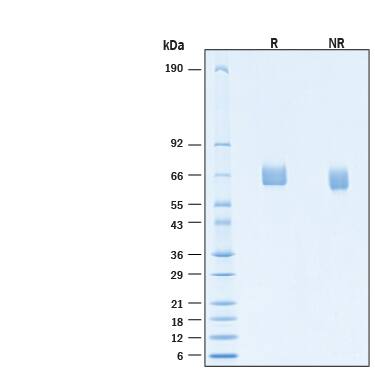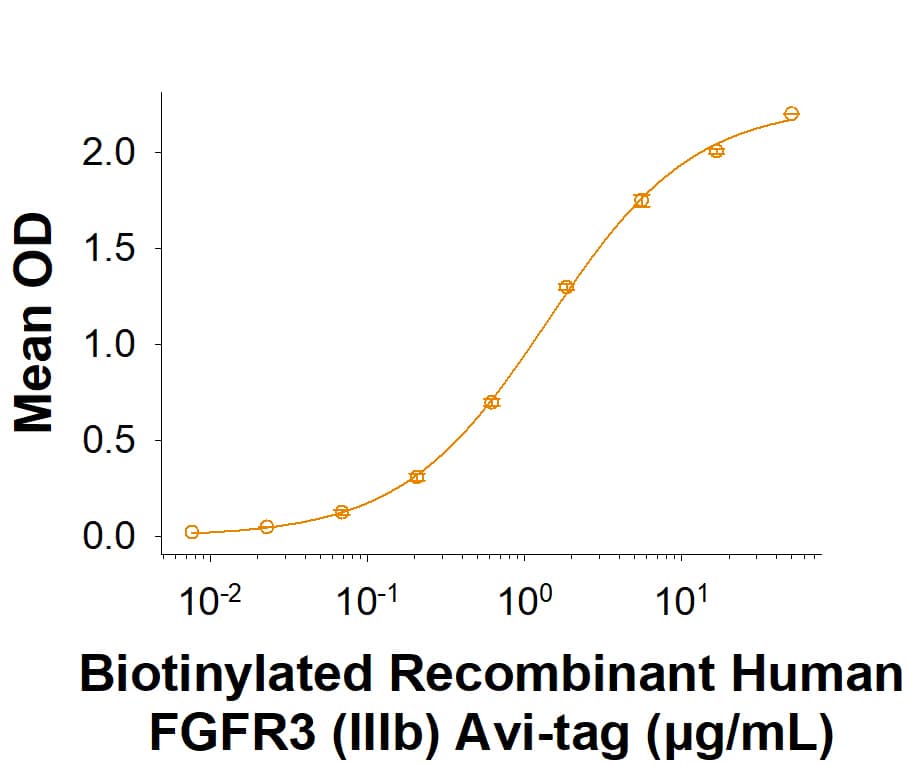Recombinant Human FGFR3 (IIIb) His-tag Avi-tag Protein, CF
R&D Systems, part of Bio-Techne | Catalog # AVI11136
Biotinylated

Key Product Details
Learn more about Avi-tag Biotinylated Proteins
Source
HEK293
Accession #
Structure / Form
Biotinylated via Avi-tag
Conjugate
Biotin
Applications
Bioactivity
Product Specifications
Source
Human embryonic kidney cell, HEK293-derived human FGFR3 protein
| Human FGFR3 (IIIb) (Glu23-Gly377) Accession # NP_001156685.1 |
6-His tag | Avi-tag |
| N-terminus | C-terminus |
Purity
>95%, by SDS-PAGE visualized with Silver Staining and quantitative densitometry by Coomassie® Blue Staining.
Endotoxin Level
<0.10 EU per 1 μg of the protein by the LAL method.
N-terminal Sequence Analysis
Glu23
Predicted Molecular Mass
41 kDa
SDS-PAGE
55-75 kDa, under reducing conditions.
Activity
Measured by its binding ability in a functional ELISA.
In a Human FGF acidic/FGF1 antibody (Catalog # AF232) coated plate, in the presence of 50.0 ng/mL of Recombinant Human FGF acidic/FGF1 (Catalog # 232-FA), Biotinylated Recombinant Human FGFR3 (IIIb) His-tag Avi-tag Protein binds with an ED50 of 1.00-6.00 µg/mL.
In a Human FGF acidic/FGF1 antibody (Catalog # AF232) coated plate, in the presence of 50.0 ng/mL of Recombinant Human FGF acidic/FGF1 (Catalog # 232-FA), Biotinylated Recombinant Human FGFR3 (IIIb) His-tag Avi-tag Protein binds with an ED50 of 1.00-6.00 µg/mL.
Scientific Data Images for Recombinant Human FGFR3 (IIIb) His-tag Avi-tag Protein, CF
Biotinylated Recombinant Human FGFR3 (IIIb) His-tag Avi-tag Protein Binding Activity.
In a Human FGF acidic/FGF1 antibody (AF232) coated plate, in the presence of 50.0 ng/mL of Recombinant Human FGF acidic/FGF1 (232-FA), Biotinylated Recombinant Human FGFR3 (IIIb) His-tag Avi-tag Protein (Catalog # AVI11136) binds with an ED50 of 1.00-6.00 µg/mL.Biotinylated Recombinant Human FGFR3 (IIIb) His-tag Avi-tag Protein SDS-PAGE.
2 μg/lane of Biotinylated Recombinant Human FGFR3 (IIIb) His-tag Avi-tag Protein (Catalog # AVI11136) was resolved with SDS-PAGE under reducing (R) and non-reducing (NR) conditions and visualized by Coomassie® Blue staining, showing bands at 55-75 kDa.Formulation, Preparation and Storage
AVI11136
| Formulation | Lyophilized from a 0.2 μm filtered solution in PBS with Trehalose. |
| Reconstitution | Reconstitute at 500 μg/mL in PBS. |
| Shipping | The product is shipped at ambient temperature. Upon receipt, store it immediately at the temperature recommended below. |
| Stability & Storage | Use a manual defrost freezer and avoid repeated freeze-thaw cycles.
|
Background: FGFR3
References
- Ornitz, D.M. and Itoh, N. (2015) Wiley Interdiscip. Rev. Dev. Biol. 4:215.
- Zhang, X. et al. (2006) J Biol. Chem. 281:15694.
- Ferguson, H.R. et al. (2021) Signaling. Cells 10:1201.
- Holzmann, K. et al. (2012) J. Nucleic. Acids. 2012:950508.
- Xie, Y. et al. (2020) Sig. Transduct. Target Ther. 5:181.
- Mossahebi-Mohammadi, M. et al. (2020) Front Cell Dev. Biol. 18:79.
- Sturla, L.M. et al. (2003) Br. J. Cancer 89:1276.
- Paur, J. et al. (2015) Hepatology. 62:1767.
- Teven, C.M. et al. (2014) Genes Dis. 1:199.
Long Name
Fibroblast Growth Factor Receptor 3
Alternate Names
CD333, CEK, FGF R3, JTK4
Gene Symbol
FGFR3
UniProt
Additional FGFR3 Products
Product Documents for Recombinant Human FGFR3 (IIIb) His-tag Avi-tag Protein, CF
Product Specific Notices for Recombinant Human FGFR3 (IIIb) His-tag Avi-tag Protein, CF
For research use only
